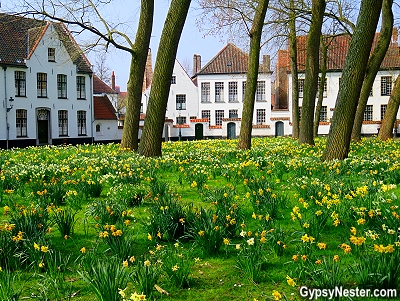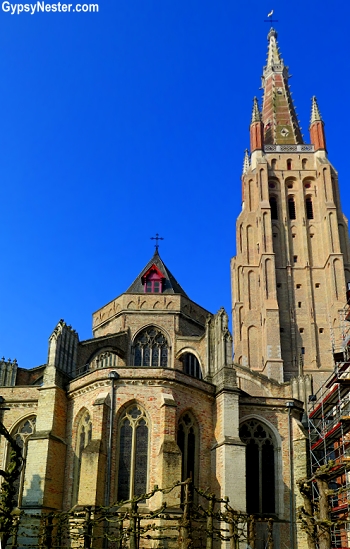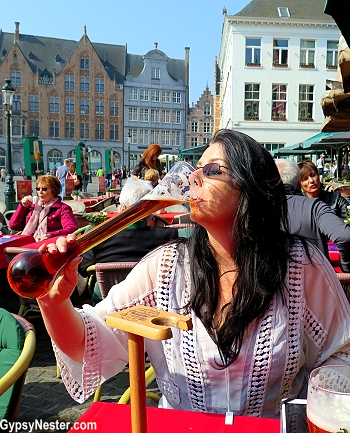Thanks to Viking River Cruises for inviting us along and providing this adventure through the tulips and windmills of Holland and Belgium with stops in Amsterdam, Kinderdijk, Antwerp, Bruges, Veere, Hoorn, and Arnhem.


Though it is no longer accessible by ship, Bruges was one of our favorite stops on our Viking River Cruise through Holland and Belgium.
Centuries ago the river was deep enough for ships and reached out to the sea. With her strategic location at the crossroads of the Hanseatic League trade and trade routes to the Mediterranean, Bruges was once the chief commercial city in the world.

Around the year 1500 sand deposits filled in the channel to the sea and the city declined, but happily much of the medieval architecture was preserved.
In the last century or so, efforts at preservation became a priority and the old town has been designated a UNESCO World Heritage Site.
All of the buildings — even businesses and private homes — can only be renovated according to strict rules that maintain the authenticity of the city.

This also means that vehicle access is restricted, so we walked along the ancient canals from the old city wall toward the two towers that dominate the skyline.

March of the Beguines
Just as we entered the city walls we came to a field filled with daffodils surrounded by what looked to be a campus.

The compound was home to Beguines, a religious order of women similar to nuns, but technically lay people.
They devoted themselves to a life of prayer and good works, but without taking vows.
The communities sprang up during the Middle Ages because there were more women than men – husbands were in short supply and being single was not terribly socially acceptable.
Following the towers

Wandering through the narrow streets and small plazas, it was easy to keep our destination in sight – we just looked for the towers.
Soon we were standing in front of the city’s main church, the Church of Our Lady, beneath the first of the towers.
The spire rises over four hundred feet high, which makes it one of the world’s tallest towers made of brick.
In addition to noteworthy tower, the church is home to Michelangelo’s sculpture of the Madonna and Child.
The work wasn’t originally intended for this church, but the Italian master sold it to a couple of Belgian merchants who brought it to Bruges in 1514. It was the only work by Michelangelo to leave Italy during his lifetime.

Chalk that up as one of the advantages of being a trade giant in those days.
Blind Donkeys

Leaving the church we turned on Blinde Ezel Straat, which we had to love because it translates to Blind Donkey Street.
And who doesn’t love a blind donkey?
The name likely stems from the practice of blindfolding donkeys to prevent them from getting dizzy while turning a mill, although there are a few more colorful legends as to its origin floating around.
At the end of the short street we passed under an ornate arcade that opened up into into a large square.
Just like the old saying about blind squirrels and acorns, it seems that even a blind donkey can find an incredible town square.


Turning around to face Blind Burro Boulevard, we see that the archway we came through connects the justice hall with the city hall, both of which are decorated with some serious statuary.
As is often the case, Justice holding her scales stands on the peak of the courthouse.
Spying Holy Blood
Next to the city hall there is a small chapel, but it looms large in the life of Bruges.
The tiny church is home to the relic of the Holy Blood, reputed to be a sample of the blood of Christ allegedly collected by Joseph of Arimathea.
Thierry of Alsace, the Count of Flanders, brought the vial back from the Second Crusade in 1150.

We went in with high hopes of seeing the amazing artifact, but the relic is kept inside a silver tabernacle.
But wait, perhaps it was just wishful thinking, but we thought we caught a peek at the vial through a sliver between the silver doors.
With no good way to corroborate our possible vision, we’re going to say yes, we saw it.

To be certain of a sighting we would have to be back in town for the annual procession through the streets celebrated on Ascension Day.
Celebrated forty days after Easter, it is always one of the city’s biggest events.
Since returning that soon felt unlikely, we figured that when in doubt, go with the better story.
Showing our mussels… and a Kwak attack

The second of the two famous towers of Bruges, the Belfort, loomed over us behind the Basilica of the Holy Blood so we walked over to the next plaza where Markt Square spreads out in front of the belfry.
We were determined to climb to the top of the tower, but the square is lined with restaurants, so first we grabbed an outdoor seat for a midday meal.
The spot we picked also happened to be a good place to delve into some Belgian beer research.
Belgium is known for beer, with a history of brewing going back nearly a thousand years.

Originally monks made the beer — and some still do — but the art has become an integral part of Belgian life.
Bruges plays a big part in that past, so to fortify ourselves for a climb up the three hundred and sixty-six steps to the top of the town’s famous bell tower we needed some traditional Belgian food and, of course, a bit of beer.
Being ignorant in the ways of the country’s brews, we chose to rely on our waiter to recommend the ultimate local beverages.
A Zot Blond is a must in Bruges; we had passed the brewery on our walk into town.
Kwak, came with the server’s endorsement as “a special beer.” We like special, so we ordered a Kwak too.
And judging by how it arrived, the Kwak must be special indeed!

The Kwak arrived in a giant glass bulb held up by a wooden stand – making the entire presentation quite the show.
It looked like something from a mad scientist’s laboratory ( or in this case pronounced lab-or-a-tory).
Folks at nearby tables were snapping pictures and asking about the Kwak – making us feel like movies stars.
The Kwak lived up to its hype – delicious.
To dilute our giant beers, we went with two of Belgium’s most typical dishes, a creamy chicken stew known as waterzooi and moules frites, which is mussels with french fries.

Never, ever called them french fries!

Oops, we must correct ourselves, it is strictly taboo to ever call fried potatoes “French” in Belgium.
Fries are without a doubt the national food, and Belgians claim to have invented them.
The French tag was supposedly due to mistaken identity by GIs from the USA during World War I.
Strengthened by our repast, we were ready to ascend the tower.
Burning off the calories by getting our bells rung

We waited in line with high hopes that seeing the clockworks, bells, and the carillon drum that controls the bells, and the view from the top, would be worth the sore legs that the seemingly never ending stairway would deliver.
We were not disappointed.

The forty seven bells of the carillon toll every fifteen minutes, so we made our first goal to go all the way to the top and wait for the next round.
Within a minute or two of making it the bells were pealing. It was certainly an eye, or more appropriately an ear, opening experience, but not as loud as we expected.

As the last of the bells reverberated, we took in the view from all angles before heading down one level to the drum room.
This is where the clockworks tick away, which also triggers the musical mechanics.
Soon the nine-ton brass drum (the largest in the world!) that controls the ringing of the bells began to turn.
The mechanism is like a giant music box. The cylinder has more than 30,000 holes where pins are arraigned to operate the hammers that strike the various carillon bells.

The huge wheel rotates and the bells ring out, but it only moves about a quarter of a turn.
Four songs are placed onto it, one for each quarter hour, and the pins can be moved and replaced to play different songs whenever it is desired.

We were simply fascinated, but time was running short.
We had to scurry, but not too quickly, down the spiral staircase to catch our bus back to the ship.
Haste needed to be combined with care because if we started rolling down the stairs, we might not have stopped until we tumbled into the middle of the square.
Bad way to end a day.
The only good thing about it would be the opportunity for another Kwak attack. Hmmm… maybe not such a bad thing after all.
David & Veronica, GypsyNester.com
See all of our adventures in Belgium!
Thanks to Viking River Cruises for inviting us along and providing this adventure through the tulips and windmills of Holland and Belgium with stops in Amsterdam, Kinderdijk, Antwerp, Bruges, Veere, Hoorn, and Arnhem.



«french» (third-person singular simple present “frenches”, present participle “frenching”, simple past and past participle “frenched”)
1. (transitive) To prepare food by cutting it into strips.
The word french in french(ed) fries comes from the verb: to french.
A Belgian
I enjoy the article
Looking forward to visiting Bruges even more than I already was. All this plus the Christmas Market in December, thanks for building the excitement.
Our pleasure Dean, have a great time!
Bruge has been on my ‘must go’ list for a while. Love your photos!
Thanks Nancy!
Veronica, your photos are wonderful. I’ve not yet been to Bruges, but would love to go! Thx for the enticement.
Thanks Doreen, hope you make it there soon.
I’ve wanted to visit ever since I saw Colin Farrell in the movie. Now I feel like I’ve had much more of a taste thanks to your terrific post. Great overview and the photo of you drinking the Kwak is a classic. How did you ever have room to eat after finishing all that special brew?
Thanks Alison! The Kwak goes great with food.
Bruges is such a wonderful place to visit. It is top on our list. Who doesn’t love, beer, fries and blind donkeys with views to die for! Loved the post.
Thanks Suzanne!
How great to have been able to see so much of Bruges and experience so many wonderful things during a relatively short stop on your Viking River Cruise! Perfect summary of a great day…
Thanks Cheryl!
Bruges (or Brügge in Flemish)) was one of our favorite places. We stayed for several days and were able to do a day long tour of the surrounding World War I battlefields and visit a brewery. They use a different type of glass for every type of beer. When we had lunch on the square, we enjoyed a cherry beer—much smaller glass than for the Kwak!
One of our favorites too Suzanne.
We loved Bruges!!! Moules frites, beer, chocolate what’s not to love. Looked like you really enjoyed that Kwak Roni!!
Loved it all, especially the Kwak attack!;)
Bruges is such a lovely city. Thanks for taking me back. I remember colorful museums and loved those fries!
I have nothing against cruises and have taken several. However, Bruges is one of those spectacular towns which really deserves a stay of 2 – 3 days and at least one night after the cruise people (Who we love) have left the city. Travel on!!
Would have loved to stay longer, no doubt, but glad we got to see it even if only for a day.
Bruges is one of my favorite cities in Europe! And Belgian fries are sold here in the Netherlands as the best kind of fries.
We loved it too. Maybe the name Belgian fries will catch on.
You managed to see an awful lot in your visit – I’ve been to Bruges many times but not seen everything that you did. But of course sampling the beer is the must do activity in any Belgian city!
We ran hard, but still had time for a beer or two. 😉
Haven’t hear of the Beguines, how interesting. We didn’t quite make it to Bruges, staying instead in Ghent. Next time.
Worth a trip Paula.
What fun you had! I loved your photos which brought back memories of my very brief visit to Bruges in 1979 – eeek! Time to go back for a more thorough look!
I am going to chant a mantra for our future travels, “Bruges or Bust!” Bruges looks like an amazing city and certainly appears to live up to its UNESCO WHS designation as a picturesque city with a fascinating history. I’ve always the carillon bells and your photos and explanation of how they worked was much appreciated!
Thanks Anita, it was great to see the inner workings.
It was fun to get a look at Bruges, which we did not have time for during our stays in Belgium. What we did have time for was beer, and you’re right, it’s among the best in the world. Too fun!
Belgium rocks their beer.
haha awesome, we were there when they took the blood out and had people go up and touch it. we wrote a post about it. Tim (not religious at all) was quite curious about what it would look like.
Great timing! Wish we had seen it.
I fell in love with Bruges when I saw the Colin Farrell film “In Bruges.” Loved the old buildings. Your photos are terrific- they make me want to be there.
Thanks Billie, we couldn’t help but have that movie running through our minds either.